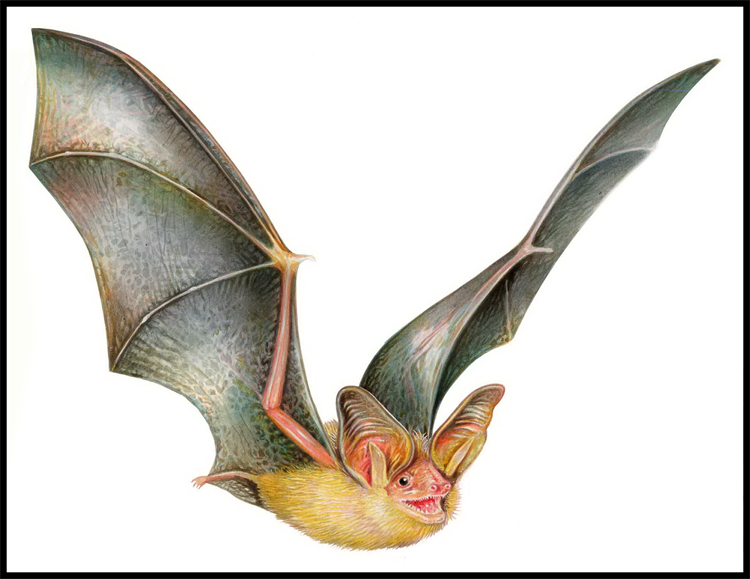Vespertilionidae
Guía de identificación de murciélagos de Chile

La taxonomía sigue las actualizaciones más recientes basadas en Simmons and Cirranello (2020a) y D'Elia et al (2020)
Eptesicus laephotis (Thomas, 1916).
Eptlae
| Parámetros | N | Min | Max | Promedio | St.Dev |
| Dur | 13 | 1.00 | 1.60 | 1.30 | 0.30 |
| TBC | 13 | 33.9 | 145.3 | 89.6 | 55.7 |
| Fmin | 13 | 24.50 | 28.10 | 26.30 | 1.80 |
| Fmax | 13 | 35.50 | 40.70 | 38.10 | 2.60 |
| BW | 13 | 11.00 | 12.60 | 11.80 | 2.60 |
| Fmean | 13 | 30.00 | 34.40 | 32.20 | 4.40 |
| FcH1 | 13 | 13.35 | 16.95 | 15.15 | 2.20 |
| Fc | 13 | 26.70 | 33.90 | 30.30 | 3.60 |
| FcH3 | 13 | 40.05 | 50.85 | 45.45 | 3.60 |
Grabado en Chile por Gonzalo Ossa
Extraído de la distribución de especies asociadas espacialmente con zonas ecológicas reconocidas para Chile (Ver Martinez et al., 2017 y Pliscoff y Fuentes-Castillo 2011)
Desde Rodríguez-San Pedro et al., 2016
|
|
Altitudes comprendidas entre los 970 y 1015 metros
I.U.C.N: Preocupación menor Soliari (2019)
Chile: En Peligro DS 06 (2017)
Histiotus se reconoce como un subgénero de Eptesicus ya que las especies de Histiotus anidan consistentemente dentro de Eptesicus en análisis moleculares. Simmons y Cirranello (2020b) y D'Elia et al. (2020).
Amador et al. (2016), Ossa et al., (2015), Roehrs et al., (2010), Ver Hoofer and Van Den Bussche (2003)
Amador, L. I., R. L. Moyers Arévalo, F. C. Almeida, S. A. Catalano, and N. P. Giannini. 2016. Bat Systematics in the Light of Unconstrained Analyses of a Comprehensive Molecular Supermatrix. Journal of Mammalian Evolution. 25: 37-70.
D’Elia, G. et al. 2020. Lista actualizada de los mamíferos vivientes de Chile. Boletín del Museo Nacional de Historia Natural, Chile 69:67–98.
DS 06/2017 MMA Decreto Supremo 06/2017 Ministerio del Medio Ambiente, http://www.mma.gob.cl/clasificacionespecies/decimo-tercer-proceso.htm
Hoofer, S. R., and P. A. Larsen. 2003. Molecular phylogenietics of the chiropteeran family Vespertilionidae. Acta Chiropterologica. 5: 1-63.
Ossa, G., C. Bonacic, and R. M. Barquez. 2015. First record of Histiotus laephotis (Thomas, 1916) from Chile and new distributional information for Histiotus montanus (Phillipi and Landbeck, 1861) (Chiroptera, Vespertilionidae). Mammalia 79.
Ossa, G., L. Forero, F. Novoa, and C. Bonacic. 2015. Caracterización morfológica y bioacústica de los murciélagos (Chiroptera) de la Reserva Nacional Pampa de Tamarugal.21-29.
Rodríguez-San Pedro, A., J. L. Allendes, and G. Ossa. 2016. Updated list of bats of Chile with comments on taxonomy, ecology, and distribution. Biodiversity and Natural History. 2: 18-41.
Roehrs, Z. P., J. B. Lack, and R. A. Van Den Bussche. 2010. Tribal phylogenetic relationships within Vespertilioninae (Chiroptera: Vespertilionidae) based on mitochondrial and nuclear sequence data. Journal of Mammalogy. 91: 1073-1092.
Simmons, N. B., and A. L. Cirranello. 2020a. Bat Species of the World: A taxonomic and geographic database. www.batnames.org
Simmons, N. B., and A. L. Cirranello. 2020b. Personal communication on rationale for including Histiotus under Eptesicus in taxonomic database.
Solari, S. 2019. Histiotus laephotis. The IUCN Red List of Threatened Species 2019: e.T136502A21974854. https://dx.doi.org/10.2305/IUCN.UK.2019-2.RLTS.T136502A21974854.en.




